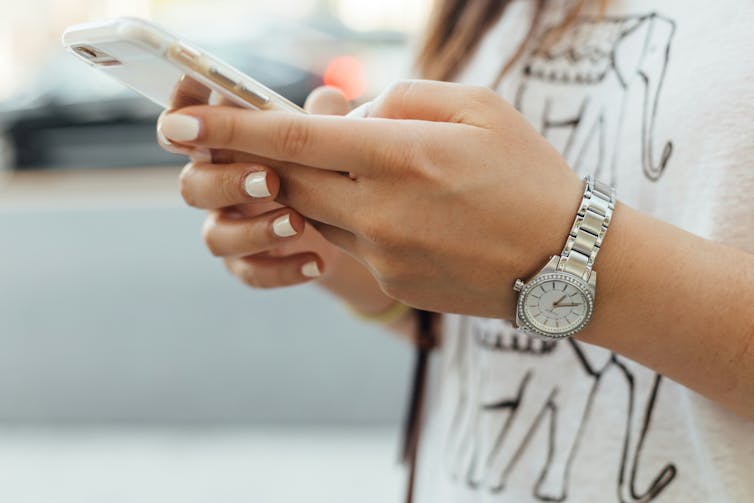Watching just eight minutes of TikTok content focused on dieting, weight loss and exercise has an immediate negative effect on body image satisfaction., writes Rachel Hogg, from Charles Sturt University in this article republished from The Conversation.
Nearly half of Australian young people are dissatisfied with the way their body looks.
Social media have only made body image issues worse for young people, leading them to compare themselves with others and strive for often unattainable – and unhealthy – beauty standards.
TikTok, which allows people to create and consume short videos, has amassed more than 1 billion users. Harmful content, including videos that glamorise disordered eating and extremely thin bodies, circulate readily on the platform.
Given most TikTok users are young, we wanted to explore how such content affects young women’s body image. Our new study found watching just eight minutes of TikTok content focused on dieting, weight loss and exercise had an immediate negative effect on body image satisfaction.
Body image and beauty standards
We recruited 273 female-identifying TikTok users aged 18 to 28 and randomly allocated them into two groups. People with a past or current eating disorder diagnosis were excluded from the study.
Participants in the experimental group were shown a 7–8 minute compilation of “pro-anorexia” and “fitspiration” content taken directly from TikTok. These video clips featured young women restricting their food intake and giving workout advice and dieting tips, such as describing their juice cleanses for weight loss.
Participants in the control group watched a 7–8 minute compilation of TikTok videos featuring “neutral” content such as videos of nature, cooking and animals.
Using a series of questionnaires, we measured levels of body image satisfaction and attitudes towards beauty standards before and after participants watched the TikTok content.
Both groups reported a decrease in body image satisfaction from before to after watching the videos. But those exposed to pro-anorexia content had the greatest decrease in body image satisfaction. They also experienced an increase in internalisation of beauty standards.
Internalisation occurs when someone accepts and identifies with external beauty standards. Exposure to harmful social media content doesn’t always result in harm – it’s when this content is internalised that body image is likely to suffer.
Before the video experiment, we asked participants some general questions about their TikTok use. We also measured preoccupation with “healthy” eating and symptoms of disordered eating.
We found participants who used TikTok for more than two hours a day reported more disordered eating behaviours than less frequent users. However, this difference was not statistically significant. This means the difference between groups did not meet the threshold required for us to conclude it was unlikely to be due to chance.
On a scale used to rate eating disorder symptoms, participants who reported high (2–3 hours a day) and extreme (more than 3 hours a day) rates of TikTok use averaged scores just below the cut-off for clinically significant eating disorder symptoms. This suggests more than two hours a day of exposure to TikTok content may be linked to disordered eating, but further research is needed to explore this.

Harmful content is widespread
The content we showed participants in the experimental group is widely circulated on TikTok, not just within “pro-ana” communities. “Clean” eating, detoxing and limited-ingredient diet trends are the wolf in lamb’s clothing of disordered eating, allowing diet culture to be rebranded as “wellness” and “self-care”. This content, alongside fitspiration, often rewards and gamifies excessive exercise and disordered eating.
Social media wellness influencers play an important role in normalising disordered eating and fitspiration content. But hashtags like #GymTok and #FoodTok allow any TikTok user to create and consume content around theirs and others’ daily eating routines, weight-loss transformations and workout routines.
What’s more, everyday users can circulate dangerous diet-related videos without the backlash a celebrity or well-known influencer might receive for sharing socially irresponsible content.
Our study only looked at short-term consequences of exposure to this sort of content on TikTok. Longitudinal research is needed to see if the negative effects we observed endure over time.
It remains difficult to censor
TikTok users have limited control over the content they’re exposed to. Because they spend much of their time on a personalised “For You” page formulated by an algorithm, a user doesn’t need to search for or follow disordered eating content to be exposed to it.
In our study, 64% of participants reported seeing disordered eating content on their For You page. Examples could include videos portraying binge eating, laxative use or excessive exercise.
Paradoxically, searching for body positivity content may make users vulnerable to seeing disordered eating content.
The most important thing TikTok users can do is to be aware that following or searching for any kind of content related to food, body or exercise may lead to inadvertent exposure to distorted body ideals. Limiting time on TikTok will limit exposure, but our findings show even less than ten minutes can have a negative effect.
Ultimately, online safety for young people depends on appropriate social media regulation. Without this, upskilling young women on how to avoid harm on social media is a bit like giving them an inflatable life jacket, then leaving them to swim indefinitely against a rip.
The TikTok reels in this article are included only to illustrate the type of content examined in this study and accessible to TikTok users. If you need support, consider contacting the Butterfly Foundation Helpline (1800 33 4673) or chat with them online. For emergency crisis support, call Lifeline on 13 11 14.
Madison Blackburn co-authored the research this article is based on.
Rachel Hogg, Senior Lecturer in Psychology, Charles Sturt University
This article is republished from The Conversation under a Creative Commons license. Read the original article.


